
About Andrew Cusack
 Writer, web designer, etc.; born in New York; educated in Argentina, Scotland, and South Africa; now based in London.
Writer, web designer, etc.; born in New York; educated in Argentina, Scotland, and South Africa; now based in London. read more
News
Blogs
Reviews & Periodicals
Arts & Design
World
France
Mitteleuropa
Knickerbockers
Argentina
The Levant
Africa
Cape of Good Hope
Netherlands
Scandinavia
Québec
India
Muscovy
Germany
Academica
The Oriental Club
Stratford House, London
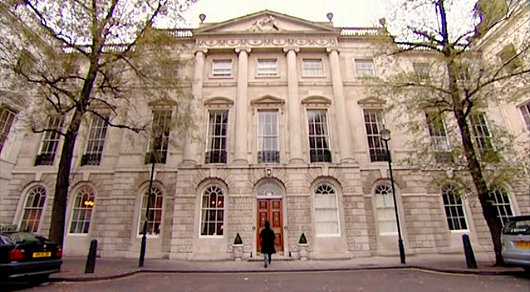
JUST STEPS AWAY 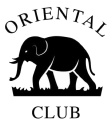 from Oxford Street, one of London’s busiest thoroughfares, rests a quiet little street called Stratford Place probably familiar only to Tanganyikans or Batswana seeking counsel from their countries’ high commissions. At the termination of the dead-end street sit the stately quarters of the Oriental Club: Stratford House. The club was founded in 1824, as British involvement and influence in both India and the Orient was waxing rapidly. General Sir John Malcolm, sometime Ambassador of His Britannic Majesty to the Court of the Peacock Throne (which is to say, Persia), coordinated the founding committee and advertised a club which would draw its members from “noblemen and gentlemen associated with the administration of our Eastern empire, or who have travelled or resided in Asia, at St. Helena, in Egypt, at the Cape of Good Hope, the Mauritius, or at Constantinople.”
from Oxford Street, one of London’s busiest thoroughfares, rests a quiet little street called Stratford Place probably familiar only to Tanganyikans or Batswana seeking counsel from their countries’ high commissions. At the termination of the dead-end street sit the stately quarters of the Oriental Club: Stratford House. The club was founded in 1824, as British involvement and influence in both India and the Orient was waxing rapidly. General Sir John Malcolm, sometime Ambassador of His Britannic Majesty to the Court of the Peacock Throne (which is to say, Persia), coordinated the founding committee and advertised a club which would draw its members from “noblemen and gentlemen associated with the administration of our Eastern empire, or who have travelled or resided in Asia, at St. Helena, in Egypt, at the Cape of Good Hope, the Mauritius, or at Constantinople.”
The club included some of the intriguing travellers of the day, amongst them Col. David Dyce Sombre. The colonel was born in Salzburg with the name of Walter Reinhard, and enlisted in the French army, during which time he acquired the moniker ‘Sombre’ on account of his general disposition. Tiring of the French he deserted and signed up with the armed forces of the Honourable East India Company which then ran the British possessions in the subcontinent. Sombre then deserted the Company and joined the Nawab Kasim Ali Khan who was engaged in a war against the British. Sometime along the way he married a Muslim woman and fathered a child named Aloysius, whom the Mughal Emperor granted the title of Zuffer Yab Khan. This marriage didn’t prevent him from engaging upon a further marriage to that eccentric and mysterious dame of the Orient, the Begum Saroo.
The Begum Saroo was one of the most spectacularly rich women of Asia, in terms of wealth in her own right. As is recounted elsewhere:
She was baptized into the Roman Catholic Church in 1781, under the name of Joanna Nobilis, but she does not appear to have been a very desirable convert, for she had two of her slave girls flogged until they were senseless, and then thrown into a pit dug in front of her tent for the purpose and burned alive, a punishment which, horrible as it was, was, in the opinion of Colonel Sleeman (Rambles and Recollections of an Indian Officer), not unmerited.
The Begum was exceedingly generous in funding the building of churches in India, as well as in her financial support for the Holy See, who went so far as to invest her designated heir, Dyce Sombre, with the Order of Christ. But this is just one of the characters involved in the early days of the club. To list more would risk continuing unceasingly.
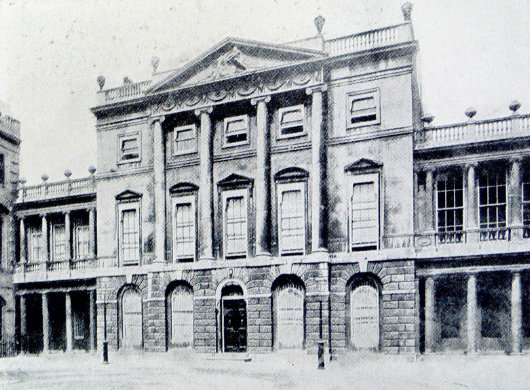
Stratford House between 1894 and 1908.
Stratford House was not the Oriental Club’s original quarters. It first met in Grosvenor Street before moving to Hanover Square where it spent its most memorable days. In 1861, its head chef Richard Terry set in motion the eventual mass popularity of Indian cuisine in Great Britain when he published his seminal work, Indian Cookery. The club became known for its preponderance of old India hands, retired bureaucrats, and former tea plantation owners past their prime. When Lytton Strachey joined in 1922, he penned a letter to Virginia Woolf saying, “I pass almost unnoticed with my glazed eyes and white hair, as I sink into a leather chair heavily, with a copy of The Field in hand. Excellent claret, too — one of the best cellars in London, by Jove!” Just a few years later another correspondent noted “the bald and venerable heads of the members of the Oriental Club, perpetually reading The Morning Post.”
Most London clubs suffered a post-war decline, but the Oriental Club was fortunate in owning the freehold to their prestigious Hanover Square address. They sold their old quarters for a tidy sum ensuring the financial health of the club, and reopened in Stratford Place just north of Oxford Street in 1962.
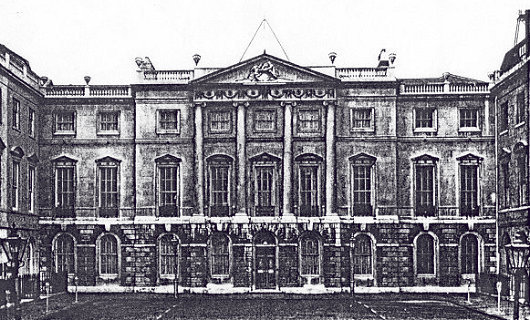
Stratford House after the 1908 additions under Lord Derby.
Stratford House was built between 1770 and 1776 to a Robert Adam design for Edward Stratford, later the Earl of Aldborough. The site was previously occupied by the banqueting hall of the Lord Mayor of London, even though it is within the boundaries of the City of Westminster. The house was built at the end of Stratford Place, which was flanked by two terraces of handsome townhouses. (On a Knickerbockerly note, Martin van Buren lived at No. 7 Stratford Place while he briefly served as the American minister to the Court of St. James). A colonnade flanked the house and connected it to the houses on either side. In 1894, a second storey was added to this colonnade, while the owner Sir Edward Colebrook (later Baron Colebrook) had the library rebuilt to a design by Adam in 1903.
The house was purchased by Lord Derby in 1908, and the double-storeyed colonnades were removed entirely so that the east and west wings were built out to meet the flanking townhouses, and the façade of Stratford House acquired the appearance it maintains to this day. Lord Derby also bought a neighbouring property in Marylebone Lane behind the houses, demolished the obsolete stables, and built a banqueting hall with a grandiose ballroom above it — the last private ballroom to be built in England.
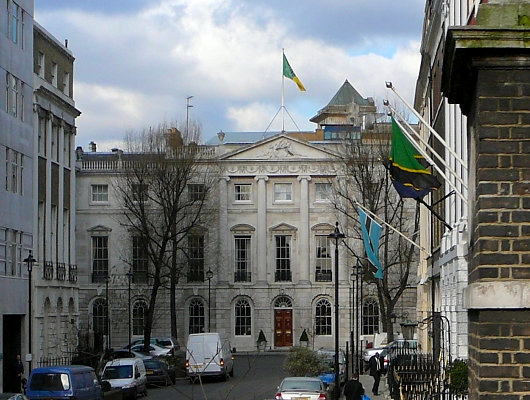
Stratford Place today.
No. 11 Stratford Place, to give its address, has had a number of names throughout the ages: Stratford House, Aldborough House, St Albans House, Derby House. The Oriental Club purchased Stratford House in 1959 and carried out numerous alterations before reopening it as club quarters in 1962. The grand ballroom was converted to two floors of bedrooms for visiting members, the banqueting hall turned into a club dining room, and lifts were installed both for members and staff.
The Oriental Club continues to flourish there today, with nearly a dozen club societies devoted to athletics, bridge, billiards, chess, golf, music, racing, shooting, and sailing, as well as the younger members society which participates in the Younger Members’ Inter-Club Group that works to keep London clubland alive for the next generation. And all this in the stately surrounds of Stratford House, “a model of discretion,” one author commented, “that may linger at the back of your eyes as you push on down past the commercial business in Oxford Street”.
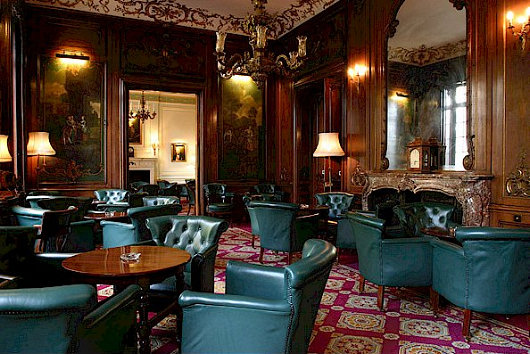
One of the Oriental Club’s two Smoking Rooms.
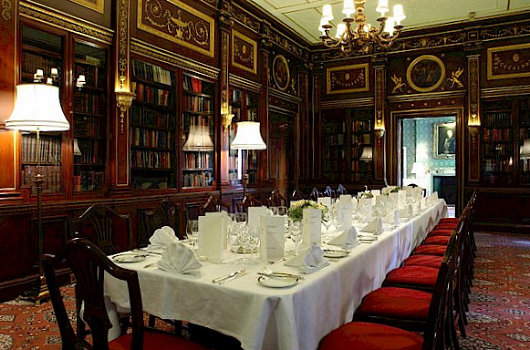
Above and below, the Club Library.
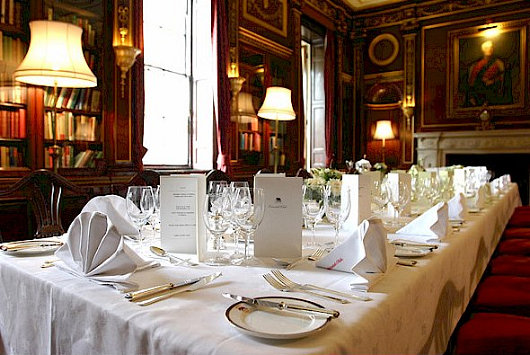
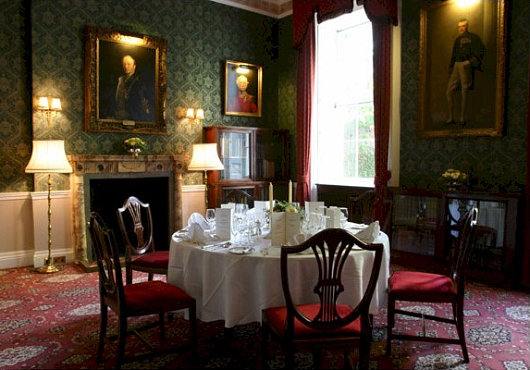
The Ante-Room to the Club Library
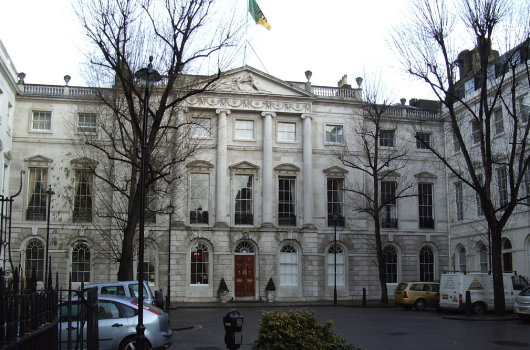
Search
Instagram: @andcusack
Click here for my Instagram photos.Most Recent Posts
- Waarburg October 2, 2024
- A Prize for the General September 23, 2024
- Articles of Note: 17 September 2024 September 17, 2024
- Equality September 16, 2024
- Rough Notes of Kinderhook September 13, 2024
Most Recent Comments
Book Wishlist
Monthly Archives
Categories



Fascinating history, Fascinating architecture. Yet another excellent find. I must admit that I saw the word “Begum” and my mind immediately went to the Aga Khan, a most peculiar man.
There’s nothing like a really, really good library to finish off a building!
The Begum Saroo sounds like fun.
I suppose the green and yellow flag is the club banner?
Quite so. Green and yellow with a black Indian elephant outlined in white.
All very well, but anyone can join these days.
This is, in fact, only not true of Whites and arguably Brooks’s, Boodles, the Beefsteak, and a very few others (not necessarily beginning with ‘B’). The vast majority are little more than semi-exclusive hotels, run ruthlessly for profit.
But then again any discerning person who has clapped eyes on London recently would not be surprised by this development. Thirteen years of Labour tyranny have done their work, and England will never be the same again.
Mr. Clark,
The decline of clubs of this sort is not limited to London. It is true to a similar extent in NY, and even more so here in San Francisco.
Exclusivity is out of fashion, even among those with legacies and inherited wealth, almost all of whom have serious professional lives. Most rich people have earned their own money. The suburbs, especially mature older, say 1920s developments, have a strong appeal to the people with children who would have belonged to these clubs.
But Cusack’s is a wise choice as exemplar of its type. I visited the Oriental several times with a late friend who was a member in the 1990s. It was a pleasure to dine there, although one of his other clubs, The Athenaeum, had a more intellectually stimulating membership.
I don’t suppose anybody there has a copy of my book, Indian Cookery, I’ve been trying to get a copy lately, but it’s just gone out of print again – I suppose we must expect these things after nearly a 150 years!
Regards
Richard Terry